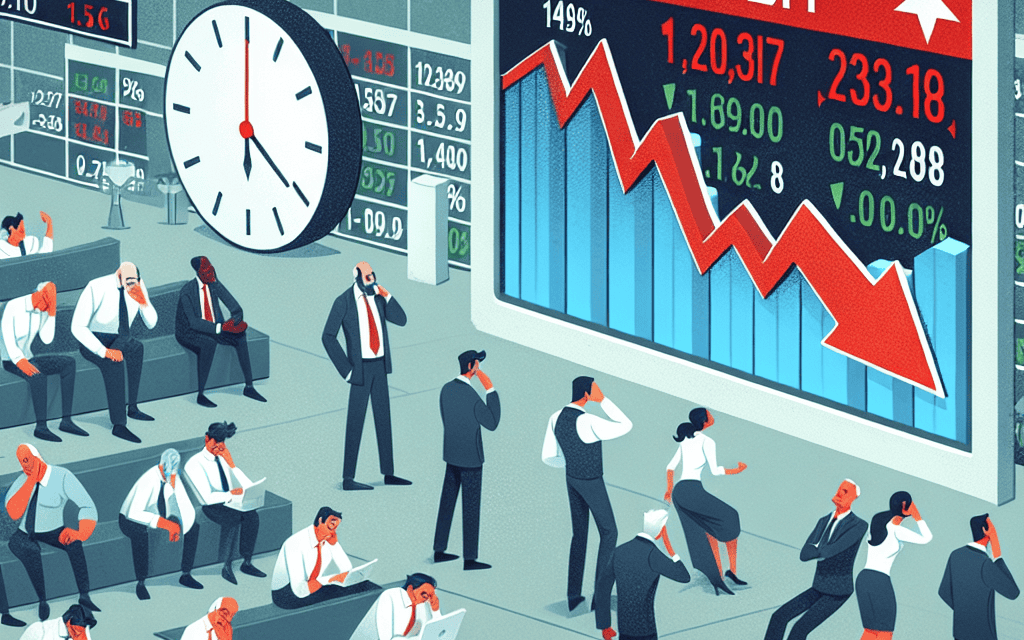“Markets Waver: Rising Yields Pressure Stocks, Tesla Shines After Hours”
Introduction
Stocks experienced a downturn as rising bond yields exerted pressure on the market, reflecting investor concerns over potential interest rate hikes and economic uncertainty. Despite the broader market decline, Tesla shares bucked the trend, posting gains in after-hours trading following positive news that bolstered investor confidence. This mixed market performance highlights the ongoing volatility and the influence of macroeconomic factors on equity valuations.
Impact Of Rising Yields On Stock Markets
In recent weeks, the financial markets have been closely monitoring the movement of bond yields, which have shown a notable upward trend. This rise in yields has exerted considerable pressure on stock markets, leading to a decline in stock prices. The relationship between bond yields and stock markets is complex, yet fundamentally intertwined. As yields increase, borrowing costs for companies also rise, potentially squeezing profit margins and dampening investor enthusiasm for equities. Consequently, higher yields often lead to a re-evaluation of stock valuations, prompting investors to reassess their portfolios and shift towards safer, income-generating assets such as bonds.
The current environment is characterized by a confluence of factors contributing to the upward trajectory of yields. Inflationary pressures, driven by robust economic recovery and supply chain disruptions, have prompted central banks to signal potential tightening of monetary policy. This has led to expectations of higher interest rates in the future, further fueling the rise in bond yields. As a result, investors are increasingly concerned about the impact of these developments on corporate earnings and economic growth, leading to heightened volatility in stock markets.
Despite the broader market downturn, certain stocks have managed to buck the trend, with Tesla being a notable example. After hours trading saw Tesla shares gain momentum, driven by positive news and investor sentiment. The electric vehicle manufacturer has consistently demonstrated resilience in the face of market fluctuations, supported by strong sales figures and ambitious expansion plans. Tesla’s ability to innovate and capture market share in the rapidly growing electric vehicle sector has bolstered investor confidence, allowing it to weather the storm of rising yields more effectively than many of its peers.
The divergence in performance between different sectors and individual stocks highlights the importance of a nuanced approach to investing in the current climate. While rising yields pose challenges for equities, they also present opportunities for discerning investors who can identify companies with strong fundamentals and growth potential. In this context, sectors such as technology and renewable energy, which are poised for long-term growth, may continue to attract investment despite short-term headwinds.
Moreover, the impact of rising yields is not uniform across all markets. Emerging markets, for instance, may face additional challenges due to their reliance on external financing and vulnerability to capital outflows. As yields rise in developed markets, investors may seek higher returns elsewhere, leading to increased volatility and potential currency depreciation in emerging economies. This underscores the need for a diversified investment strategy that takes into account the varying dynamics of different regions and asset classes.
In conclusion, the rise in bond yields has introduced a new layer of complexity to the investment landscape, prompting investors to reassess their strategies and adapt to changing conditions. While the immediate impact on stock markets has been negative, the long-term implications are less clear and will depend on a range of factors, including the trajectory of inflation, central bank policies, and global economic growth. As such, investors must remain vigilant and flexible, ready to capitalize on opportunities as they arise while managing the risks associated with a shifting financial environment.
Tesla’s After-Hours Performance: A Closer Look
In the ever-evolving landscape of financial markets, investors are constantly on the lookout for indicators that could influence their portfolios. Recently, the stock market experienced a downturn as rising yields exerted pressure on equities. However, amidst this broader market decline, Tesla emerged as a notable exception, posting gains in after-hours trading. This development warrants a closer examination of Tesla’s performance and the factors contributing to its resilience in the face of broader market challenges.
To begin with, the broader market’s decline can be attributed to the rising yields on government bonds, which have historically been a harbinger of increased borrowing costs for companies. As yields rise, the attractiveness of equities diminishes, leading investors to reassess their positions. This shift in sentiment was evident as major indices, including the S&P 500 and the Dow Jones Industrial Average, registered losses. The increase in yields is often interpreted as a signal of tightening monetary policy, which can dampen economic growth prospects and, consequently, corporate earnings.
In contrast to the general market trend, Tesla’s shares experienced a surge in after-hours trading. This divergence can be attributed to several factors that have bolstered investor confidence in the electric vehicle giant. Firstly, Tesla’s recent earnings report exceeded market expectations, showcasing robust revenue growth and improved profit margins. The company’s ability to navigate supply chain disruptions and maintain production levels has been a testament to its operational resilience. Moreover, Tesla’s expansion into new markets and its continued investment in innovative technologies have positioned it as a leader in the transition to sustainable energy.
Furthermore, Tesla’s strategic initiatives have played a crucial role in enhancing its market position. The company’s foray into energy storage solutions and its advancements in autonomous driving technology have opened new revenue streams and diversified its business model. These initiatives not only underscore Tesla’s commitment to innovation but also provide a buffer against potential market volatility. As a result, investors have shown a willingness to overlook short-term market fluctuations in favor of Tesla’s long-term growth prospects.
Additionally, Tesla’s charismatic CEO, Elon Musk, continues to be a driving force behind the company’s success. His vision for the future of transportation and energy has resonated with investors, fostering a sense of optimism about Tesla’s potential to disrupt traditional industries. Musk’s ability to communicate this vision effectively has been instrumental in maintaining investor confidence, even during periods of market uncertainty.
It is also worth noting that Tesla’s performance in after-hours trading reflects broader trends in the electric vehicle sector. As governments worldwide implement stricter emissions regulations and consumers increasingly prioritize sustainability, the demand for electric vehicles is expected to rise. Tesla, with its established brand and technological prowess, is well-positioned to capitalize on this shift. Consequently, investors are keen to gain exposure to the electric vehicle market through Tesla, further driving its stock performance.
In conclusion, while rising yields have cast a shadow over the broader stock market, Tesla’s after-hours gains highlight the company’s unique position in the financial landscape. Through a combination of strong financial performance, strategic initiatives, and visionary leadership, Tesla has managed to capture the attention of investors and maintain its upward trajectory. As the market continues to navigate the challenges posed by rising yields, Tesla’s resilience serves as a reminder of the importance of innovation and adaptability in the ever-changing world of finance.
Understanding The Relationship Between Yields And Stock Prices
In the intricate world of financial markets, the interplay between stock prices and bond yields is a subject of perennial interest to investors and analysts alike. Recently, stock markets have experienced a downturn, primarily attributed to rising bond yields. This phenomenon underscores the complex relationship between these two financial instruments, which often move inversely to one another. To comprehend this dynamic, it is essential to delve into the underlying mechanisms that govern the behavior of stocks and bonds.
At the core of this relationship is the concept of opportunity cost. When bond yields rise, they offer higher returns to investors, making them more attractive compared to stocks. Consequently, investors may shift their capital from equities to bonds, leading to a decline in stock prices. This shift is particularly pronounced when yields on government bonds, considered risk-free, increase, as they set a benchmark for other interest rates in the economy. As yields climb, the cost of borrowing also rises, which can dampen corporate profits and, by extension, stock valuations.
Moreover, rising yields often signal expectations of higher inflation or tighter monetary policy. Central banks, such as the Federal Reserve, may raise interest rates to curb inflation, which can further elevate bond yields. Higher interest rates increase the cost of capital for companies, potentially slowing down economic growth and reducing future cash flows. Investors, anticipating these developments, may adjust their portfolios accordingly, favoring bonds over stocks.
However, the relationship between yields and stock prices is not always straightforward. Various factors can influence market dynamics, leading to deviations from the typical inverse correlation. For instance, if rising yields are driven by robust economic growth, the positive outlook for corporate earnings may offset the negative impact of higher borrowing costs. In such scenarios, stocks may continue to perform well despite increasing yields, as investors remain optimistic about future profitability.
Amidst the broader market decline, certain stocks can defy the trend, as evidenced by Tesla’s recent gains in after-hours trading. Tesla’s performance highlights the importance of company-specific factors in determining stock prices. Positive news, such as strong earnings reports, product launches, or strategic partnerships, can bolster investor confidence and drive stock prices higher, even in a challenging macroeconomic environment. Tesla’s resilience in the face of rising yields underscores the significance of innovation and market leadership in sustaining investor interest.
In conclusion, understanding the relationship between yields and stock prices requires a nuanced analysis of both macroeconomic indicators and company-specific developments. While rising yields generally exert downward pressure on stock markets, the impact can vary depending on the broader economic context and individual company performance. Investors must remain vigilant, considering both the potential risks and opportunities presented by changing market conditions. By doing so, they can navigate the complexities of financial markets and make informed investment decisions. As the landscape continues to evolve, staying attuned to these dynamics will be crucial for achieving long-term financial success.
Key Factors Driving Tesla’s Stock Gains

In recent trading sessions, the financial markets have been characterized by a notable decline in stock prices, primarily driven by rising bond yields. This trend has sparked concerns among investors, as higher yields often signal increased borrowing costs for companies, potentially impacting their profitability. However, amidst this broader market downturn, Tesla has emerged as a standout performer, experiencing gains in after-hours trading. Several key factors have contributed to this upward movement in Tesla’s stock, offering insights into the dynamics at play.
Firstly, Tesla’s recent financial performance has been a significant driver of its stock gains. The company reported robust quarterly earnings that exceeded analysts’ expectations, showcasing its ability to navigate a challenging economic environment. This strong financial performance has reinforced investor confidence in Tesla’s business model and growth prospects, particularly as it continues to expand its production capabilities and global market presence. Moreover, Tesla’s ability to maintain healthy profit margins despite rising input costs has further bolstered its appeal to investors seeking resilient growth stocks.
In addition to its financial performance, Tesla’s strategic initiatives have played a crucial role in its stock’s positive trajectory. The company’s ongoing efforts to innovate and diversify its product offerings have captured the attention of both consumers and investors. For instance, Tesla’s advancements in battery technology and energy storage solutions have positioned it as a leader in the transition to sustainable energy. These innovations not only enhance Tesla’s competitive edge but also align with the growing global emphasis on environmental sustainability, making the company an attractive investment for those prioritizing environmental, social, and governance (ESG) criteria.
Furthermore, Tesla’s expansion into new markets has been a pivotal factor in its stock gains. The company’s recent entry into emerging markets, coupled with its plans to establish manufacturing facilities in strategic locations, underscores its commitment to scaling operations and tapping into new customer bases. This geographic diversification not only mitigates risks associated with over-reliance on specific markets but also opens up opportunities for revenue growth. As Tesla continues to penetrate these markets, its ability to capture market share and drive sales growth is likely to remain a focal point for investors.
Another contributing factor to Tesla’s stock performance is the broader industry trends favoring electric vehicles (EVs). The global shift towards EV adoption, driven by regulatory support and changing consumer preferences, has created a favorable environment for Tesla. As governments worldwide implement stricter emissions regulations and incentivize EV adoption, Tesla stands to benefit from increased demand for its vehicles. This industry tailwind, combined with Tesla’s brand recognition and technological leadership, positions the company to capitalize on the growing EV market.
Lastly, investor sentiment and market dynamics have also influenced Tesla’s stock gains. Despite the broader market volatility, Tesla’s stock has been buoyed by positive sentiment from institutional investors and analysts. Upbeat analyst ratings and target price revisions have contributed to the stock’s momentum, as investors anticipate continued growth and innovation from the company. Additionally, Tesla’s strong brand loyalty and dedicated customer base have fostered a sense of optimism about its long-term prospects, further supporting its stock performance.
In conclusion, while rising bond yields have exerted downward pressure on the broader stock market, Tesla’s stock has defied this trend, driven by a combination of strong financial performance, strategic initiatives, market expansion, industry trends, and positive investor sentiment. As Tesla continues to navigate the evolving economic landscape, these factors are likely to remain integral to its stock’s trajectory, offering valuable insights for investors and market observers alike.
Market Volatility: How Rising Yields Affect Investor Sentiment
In recent weeks, financial markets have experienced heightened volatility, primarily driven by rising bond yields. This development has significantly impacted investor sentiment, leading to fluctuations in stock prices. As yields on government bonds increase, they often signal expectations of higher interest rates, which can have a profound effect on equity markets. Investors tend to reassess their portfolios in response to these changes, as higher yields make bonds more attractive compared to stocks, which are generally considered riskier investments. Consequently, this shift in preference can lead to a sell-off in equities, as seen in the recent downturn in stock markets.
The relationship between bond yields and stock prices is complex, yet crucial for understanding market dynamics. When yields rise, borrowing costs for companies also increase, potentially squeezing profit margins and reducing future earnings prospects. This scenario can lead to a reevaluation of stock valuations, particularly for growth-oriented companies that rely heavily on borrowing to finance expansion. As a result, sectors such as technology, which have been the darlings of the market in recent years, may face increased pressure. Investors, therefore, become more cautious, seeking safer havens for their capital.
Despite the broader market’s decline, certain stocks have managed to buck the trend, with Tesla being a notable example. After hours, Tesla shares gained momentum, driven by positive news that bolstered investor confidence. The electric vehicle manufacturer reported stronger-than-expected quarterly earnings, highlighting its ability to navigate supply chain challenges and maintain robust demand for its products. This performance reassured investors about Tesla’s growth trajectory, even amid a challenging macroeconomic environment. Consequently, the company’s stock saw an uptick, providing a glimmer of optimism in an otherwise turbulent market.
Moreover, the interplay between rising yields and stock performance underscores the importance of diversification in investment strategies. As market conditions evolve, investors are reminded of the need to balance their portfolios across different asset classes to mitigate risk. While equities may face headwinds from rising yields, other assets, such as commodities or real estate, might offer alternative opportunities for returns. This approach allows investors to navigate periods of uncertainty with greater resilience, ensuring that their portfolios are not overly exposed to any single market factor.
In addition to diversification, staying informed about macroeconomic trends is essential for investors seeking to make informed decisions. Understanding the implications of rising yields, central bank policies, and economic indicators can provide valuable insights into potential market movements. By keeping abreast of these developments, investors can better anticipate shifts in sentiment and adjust their strategies accordingly. This proactive approach can help mitigate the impact of market volatility and enhance long-term investment outcomes.
In conclusion, the recent rise in bond yields has introduced a new layer of complexity to financial markets, affecting investor sentiment and stock performance. While some companies, like Tesla, have managed to thrive despite these challenges, the broader market remains susceptible to fluctuations. As investors navigate this environment, diversification and informed decision-making become paramount. By understanding the intricate relationship between yields and equities, investors can better position themselves to weather market volatility and capitalize on emerging opportunities. As always, maintaining a balanced perspective and staying attuned to macroeconomic trends will be key to achieving investment success in these uncertain times.
Analyzing The Broader Market Trends Amidst Yield Increases
In recent weeks, the financial markets have been closely monitoring the fluctuations in bond yields, which have shown a marked increase, leading to a ripple effect across various sectors. The rise in yields has been primarily driven by expectations of tighter monetary policy as central banks respond to persistent inflationary pressures. This development has prompted investors to reassess their portfolios, leading to a noticeable decline in stock prices. As yields rise, the cost of borrowing increases, which can dampen corporate profits and, consequently, investor sentiment. This shift in the economic landscape has been particularly evident in the technology sector, where high-growth companies are often more sensitive to changes in interest rates due to their reliance on future earnings.
Amidst this backdrop, the broader market trends reveal a cautious approach by investors who are recalibrating their strategies to navigate the evolving financial environment. The increase in yields has made fixed-income securities more attractive, drawing capital away from equities. This reallocation of assets has contributed to the downward pressure on stock prices, as investors seek safer havens in the face of potential market volatility. Furthermore, the rising yields have sparked concerns about the sustainability of economic growth, as higher borrowing costs could lead to reduced consumer spending and business investment.
Despite the overall decline in stock prices, certain companies have managed to buck the trend, with Tesla being a notable example. The electric vehicle manufacturer has seen its shares gain traction in after-hours trading, driven by positive developments that have captured the attention of investors. Tesla’s recent performance can be attributed to a combination of strong quarterly earnings and optimistic projections for future growth. The company’s ability to navigate supply chain challenges and maintain robust production levels has instilled confidence among investors, who view Tesla as a leader in the transition to sustainable energy.
Moreover, Tesla’s strategic initiatives, such as expanding its global footprint and investing in new technologies, have further bolstered its market position. These efforts have not only enhanced Tesla’s competitive edge but also underscored its potential for long-term growth, even amidst a challenging economic environment. As a result, Tesla’s stock has emerged as a bright spot in an otherwise subdued market, highlighting the importance of innovation and adaptability in navigating the complexities of the current financial landscape.
In conclusion, the recent rise in bond yields has had a profound impact on the broader market trends, prompting investors to adopt a more cautious stance. The shift towards fixed-income securities has exerted downward pressure on stock prices, as concerns about economic growth and corporate profitability persist. However, companies like Tesla have demonstrated resilience, capitalizing on their strategic strengths to deliver positive results. As the financial markets continue to evolve, investors will need to remain vigilant, balancing the risks and opportunities presented by the changing economic conditions. By staying informed and adaptable, market participants can better position themselves to navigate the challenges and capitalize on the potential rewards that lie ahead.
Strategies For Investors In A High-Yield Environment
In the current financial landscape, investors are navigating a complex environment characterized by rising yields and fluctuating stock markets. As yields on government bonds increase, the stock market has experienced a corresponding decline, reflecting the intricate relationship between these two financial instruments. Rising yields often signal higher borrowing costs, which can dampen corporate profits and, consequently, investor sentiment. This dynamic has been evident in recent market movements, where stocks have fallen in response to the upward trajectory of yields. However, amidst this backdrop, certain stocks, such as Tesla, have shown resilience, gaining traction in after-hours trading. This divergence highlights the importance of strategic investment approaches in a high-yield environment.
To effectively navigate this landscape, investors must first understand the implications of rising yields. Higher yields typically indicate expectations of economic growth and potential inflationary pressures. While this can be positive for certain sectors, it poses challenges for others, particularly those reliant on borrowing. Consequently, investors should consider adjusting their portfolios to mitigate risks associated with increased borrowing costs. One strategy is to focus on companies with strong balance sheets and low debt levels, as these firms are better positioned to weather the impact of rising interest rates.
Moreover, diversification remains a crucial strategy in managing risk. By spreading investments across various asset classes, sectors, and geographies, investors can reduce their exposure to any single market downturn. In a high-yield environment, this might involve increasing allocations to sectors that traditionally benefit from rising rates, such as financials, which can experience improved profit margins as interest rates climb. Additionally, commodities and real estate investment trusts (REITs) may offer attractive opportunities, as they often serve as hedges against inflation.
Another consideration for investors is the potential for value stocks to outperform growth stocks in a rising yield scenario. Value stocks, typically characterized by lower price-to-earnings ratios and higher dividend yields, may become more attractive as investors seek stable returns in a volatile market. Conversely, growth stocks, which often rely on future earnings potential, may face headwinds as higher discount rates reduce the present value of their expected cash flows. Therefore, a strategic shift towards value-oriented investments could enhance portfolio resilience.
Furthermore, investors should remain vigilant and adaptable, as market conditions can change rapidly. Monitoring economic indicators, such as inflation rates and central bank policies, can provide valuable insights into future yield movements. Staying informed enables investors to make timely adjustments to their strategies, ensuring alignment with evolving market dynamics.
In light of these considerations, it is also essential to maintain a long-term perspective. While short-term market fluctuations can be unsettling, a focus on long-term goals and disciplined investment practices can help investors navigate periods of uncertainty. This approach involves maintaining a well-balanced portfolio, regularly reviewing asset allocations, and resisting the urge to make impulsive decisions based on market volatility.
In conclusion, the current high-yield environment presents both challenges and opportunities for investors. By understanding the implications of rising yields, diversifying portfolios, considering value stocks, and maintaining a long-term perspective, investors can develop strategies to effectively manage risk and capitalize on potential gains. As the market continues to evolve, staying informed and adaptable will be key to achieving investment success in this dynamic landscape.
Q&A
1. **Question:** What caused the stock market to fall in the recent update?
– **Answer:** The stock market fell due to rising yields.
2. **Question:** How did Tesla’s stock perform after hours?
– **Answer:** Tesla’s stock gained after hours.
3. **Question:** What is the general impact of rising yields on the stock market?
– **Answer:** Rising yields generally lead to a decrease in stock market values as they increase borrowing costs and make bonds more attractive compared to stocks.
4. **Question:** Which sector is most likely to be affected by rising yields?
– **Answer:** The technology sector is often most affected by rising yields due to its reliance on borrowing for growth and expansion.
5. **Question:** What might be a reason for Tesla’s stock to gain after hours despite the overall market decline?
– **Answer:** Tesla’s stock might have gained after hours due to positive company-specific news, such as strong earnings reports or favorable analyst ratings.
6. **Question:** How do rising yields affect investor sentiment?
– **Answer:** Rising yields can lead to negative investor sentiment as they signal higher interest rates, which can slow economic growth and reduce corporate profits.
7. **Question:** What is a potential strategy for investors during periods of rising yields?
– **Answer:** Investors might consider shifting their portfolios towards sectors that benefit from higher interest rates, such as financials, or increasing their allocation to bonds.
Conclusion
In the latest market update, stocks experienced a decline primarily due to rising yields, which often signal increased borrowing costs and can negatively impact equity valuations. Despite the broader market downturn, Tesla shares saw gains in after-hours trading, suggesting positive investor sentiment or company-specific news that outweighed the general market trend. This divergence highlights the complex dynamics at play, where individual stock performance can defy broader market movements based on unique factors.





